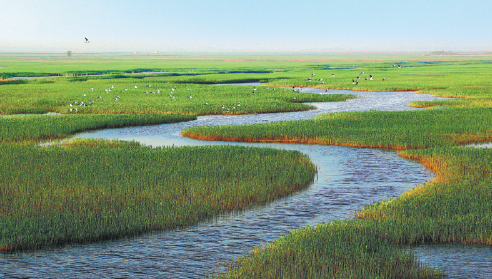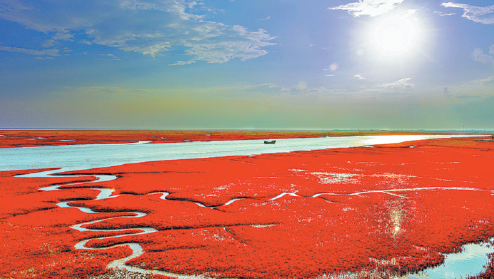Rice production in Panjin largest in Northeast China
Despite being one of the smallest cities in Northeast China's Liaoning province, Panjin is punching above its weight in terms of its wealth in natural resources.
The city of almost 1.5 million people is one of Northeast China's main biggest rice growers with over 100,000 hectares of land producing 1.04 million metric tons of rice annually. The brand value of Panjin rice has reached more than 52 billion yuan($7.8 billion).
The reason rice growing flourishes in Panjin is that 80 percent of the city's total area-3,149 square kilometers, is wetlands fed by an estuary on the lower reaches of the Liaohe River.
One of the most striking areas of the wetlands is an area known as Red Beach, famous for its striking blood-red seepweed. Its growth cycle begins in April with the reeds a light red; the color deepens as the reeds mature.
The 5A-level scenic spot, China's highest ranking, stretches 18 km,making it the world's largest wetland. The Red Beach National Scenic Corridor receives over 1 million visitors a year and generates a tourism income of over 70 million yuan annually.
To better protect its natural resources, Panjin established a nature reserve in its Shuangtai River estuary in 1985, and was upgraded to State level in 1988.
Covering an area 80,000 hectares,the reserve accounts for 50 percent of the city's wetlands.
In 2019, the nature reserve was renamed the Liaohekou National Nature Reserve.
The Liaohekou National Nature Reserve is China's largest coastal wetlands in terms of size and diversity of wildlife.
It serves as an important roosting place and breeding ground for migratory birds, and is also a major habitat for aquatic birds. It has nine kinds of first-grade State protected animals and 39 kinds of second-grade State protected animals. The number of wild red-crowned cranes at the reserve accounts for 45 percent of the world's total. The number of Oriental white storks accounts for 25 percent of the world's total, and its white cranes account for 20 percent of the world's total.
The reserve is also home to a group of endangered species such as the Saunder's gull, black-faced spoonbill and white spoonbill, making it a valuable gene pool of wildlife species. It maintains an important position in international wetlands and plays a key role in wetland biodiversity conservation.
Thanks to years of efforts, Panjin's wetlands have become one of the best-preserved original ecological environments in China winning many honorary titles. The city's Liaohekou National Nature Reserve joined the East Asian and Australian bird migration route protected area network in 1996 and the Northeast Asian Crane Network in 2000.
Not to be outdone, Panjin is also home to Northeast China's largest artificial breeding area for hairy crabs, selling 72,000 tons annually.

Reed marshes in Panjin in Northeast China's Liaoning province provide an ideal habitat for migratory birds. CHINA DAILY

The Red Beach in Panjin is listed as a national 5A-level scenic spot and is famous for its striking red seepweed. CHINA DAILY